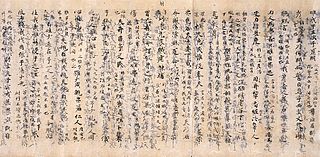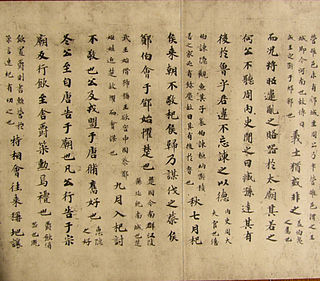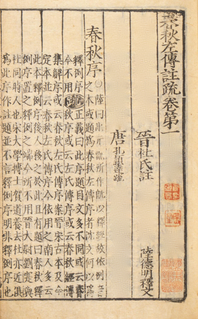 W
WThe Book of Documents or Classic of History, also known as the Shangshu, is one of the Five Classics of ancient Chinese literature. It is a collection of rhetorical prose attributed to figures of ancient China, and served as the foundation of Chinese political philosophy for over 2,000 years.
 W
WThe Shiben or Book of Origins was the earliest Chinese encyclopedia which recorded imperial genealogies from the mythical Three Sovereigns and Five Emperors down to the late Spring and Autumn period, explanations of the origin of clan names, and records of legendary and historical Chinese inventors. It was written during the 2nd century BC at the time of the Han dynasty.
 W
WThe Spring and Autumn Annals or Chunqiu is an ancient Chinese chronicle that has been one of the core Chinese classics since ancient times. The Annals is the official chronicle of the State of Lu, and covers a 241-year period from 722 to 481 BC. It is the earliest surviving Chinese historical text to be arranged in annals form. Because it was traditionally regarded as having been compiled by Confucius, it was included as one of the Five Classics of Chinese literature.
 W
WThe Weilüe was a Chinese historical text written by Yu Huan between 239 and 265. Yu Huan was an official in the state of Cao Wei (220–265) during the Three Kingdoms period (220–280). Although not a formal historian, Yu Huan has been held in high regard among Chinese scholars. As per the texts, Roman travelers and traders of those times claimed that Roman elites were descendants of immigrants from ancient Chinese nobility and Parthian elites were descendants of ancient North Indian empires.
 W
WThe Yingya Shenglan, written by Ma Huan, is a book about the countries visited by him over the course of the Ming treasure voyages led by Zheng He.
 W
WThe Zizhi Tongjian is a pioneering reference work in Chinese historiography, published in 1084 AD during the Song dynasty in the form of a chronicle. In 1065 AD, Emperor Yingzong of Song ordered the great historian Sima Guang to lead with other scholars such as his chief assistants Liu Shu, Liu Ban and Fan Zuyu, the compilation of a universal history of China. The task took 19 years to complete, and in 1084 AD, it was presented to his successor Emperor Shenzong of Song. The Zizhi Tongjian records Chinese history from 403 BC to 959 AD, covering 16 dynasties and spanning across almost 1400 years, and contains 294 volumes (卷) and about 3 million Chinese characters.
 W
WThe Zuo zhuan, generally translated The Zuo Tradition or The Commentary of Zuo, is an ancient Chinese narrative history that is traditionally regarded as a commentary on the ancient Chinese chronicle Spring and Autumn Annals . It comprises 30 chapters covering a period from 722 to 468 BC, and focuses mainly on political, diplomatic, and military affairs from that era. The Zuo zhuan is famous for its "relentlessly realistic" style, and recounts many tense and dramatic episodes, such as battles and fights, royal assassinations and murder of concubines, deception and intrigue, excesses, citizens' oppression and insurgences, and appearances of ghosts and cosmic portents.